Organisational Behaviour Report: Theories for SuperValu Management
VerifiedAdded on 2022/08/23
|23
|5027
|18
Report
AI Summary
This report analyzes organizational behavior models for SuperValu, an Irish supermarket chain. It examines three key pillars: individual, group, and organizational levels. At the individual level, the report analyzes Herzberg's Two-Factor Theory and Maslow's Hierarchy of Needs, concluding that Herzberg's theory is most suitable for motivating employees through job satisfaction and hygiene factors. For the group level, the report assesses Gersick's Punctuated Equilibrium Model and Tuckman's Team Development Model, with Tuckman's model deemed most appropriate for team development. Finally, at the organizational level, Kotter's 8-Step Change Model and Leader-Member Exchange (LMX) Theory are evaluated, with LMX theory selected for its focus on leader-member relationships. The report provides explanations, applications, strengths, and weaknesses for each theory, offering a comprehensive overview of organizational behavior principles within the context of SuperValu's operations.

Running head: MANAGEMENT
Management
Name of the Student
Name of the University
Author note
Management
Name of the Student
Name of the University
Author note
Paraphrase This Document
Need a fresh take? Get an instant paraphrase of this document with our AI Paraphraser

1MANAGEMENT
Executive Summary
The report has thrown light in analysing the different kinds of theories and models which can be
playing a vital role in managing the different perspectives in the company successfully. In the
competitive business environment, there are three major levels in OB that includes individual,
group and organization wherein there are different issues and concerns faced by the levels. In
such scenarios, there are different kinds of theories such as change management, motivation
along with leadership and member exchange theory that will be beneficial in improving the
growth prospects of the company as a whole.
Executive Summary
The report has thrown light in analysing the different kinds of theories and models which can be
playing a vital role in managing the different perspectives in the company successfully. In the
competitive business environment, there are three major levels in OB that includes individual,
group and organization wherein there are different issues and concerns faced by the levels. In
such scenarios, there are different kinds of theories such as change management, motivation
along with leadership and member exchange theory that will be beneficial in improving the
growth prospects of the company as a whole.
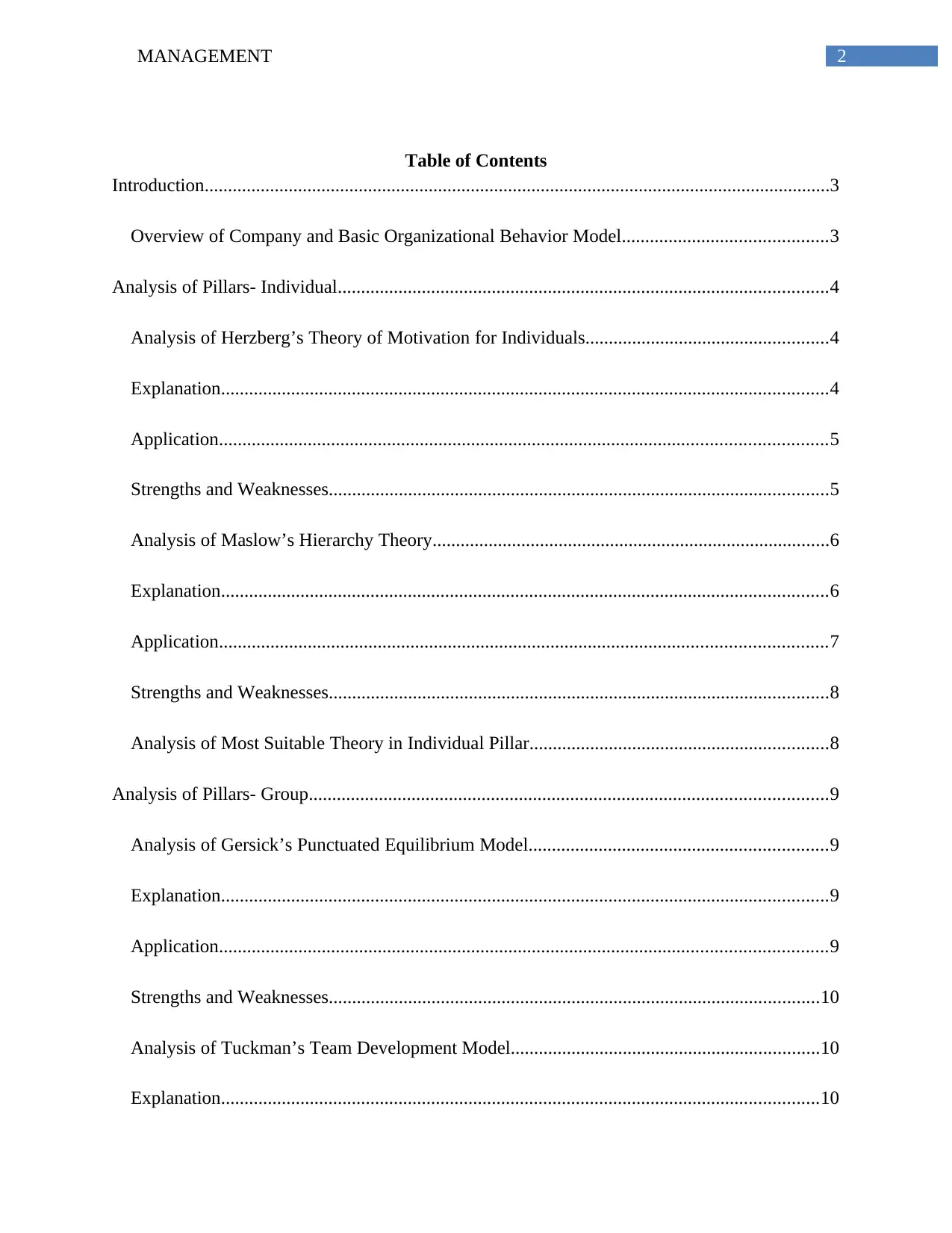
2MANAGEMENT
Table of Contents
Introduction......................................................................................................................................3
Overview of Company and Basic Organizational Behavior Model............................................3
Analysis of Pillars- Individual.........................................................................................................4
Analysis of Herzberg’s Theory of Motivation for Individuals....................................................4
Explanation..................................................................................................................................4
Application..................................................................................................................................5
Strengths and Weaknesses...........................................................................................................5
Analysis of Maslow’s Hierarchy Theory.....................................................................................6
Explanation..................................................................................................................................6
Application..................................................................................................................................7
Strengths and Weaknesses...........................................................................................................8
Analysis of Most Suitable Theory in Individual Pillar................................................................8
Analysis of Pillars- Group...............................................................................................................9
Analysis of Gersick’s Punctuated Equilibrium Model................................................................9
Explanation..................................................................................................................................9
Application..................................................................................................................................9
Strengths and Weaknesses.........................................................................................................10
Analysis of Tuckman’s Team Development Model..................................................................10
Explanation................................................................................................................................10
Table of Contents
Introduction......................................................................................................................................3
Overview of Company and Basic Organizational Behavior Model............................................3
Analysis of Pillars- Individual.........................................................................................................4
Analysis of Herzberg’s Theory of Motivation for Individuals....................................................4
Explanation..................................................................................................................................4
Application..................................................................................................................................5
Strengths and Weaknesses...........................................................................................................5
Analysis of Maslow’s Hierarchy Theory.....................................................................................6
Explanation..................................................................................................................................6
Application..................................................................................................................................7
Strengths and Weaknesses...........................................................................................................8
Analysis of Most Suitable Theory in Individual Pillar................................................................8
Analysis of Pillars- Group...............................................................................................................9
Analysis of Gersick’s Punctuated Equilibrium Model................................................................9
Explanation..................................................................................................................................9
Application..................................................................................................................................9
Strengths and Weaknesses.........................................................................................................10
Analysis of Tuckman’s Team Development Model..................................................................10
Explanation................................................................................................................................10
⊘ This is a preview!⊘
Do you want full access?
Subscribe today to unlock all pages.

Trusted by 1+ million students worldwide
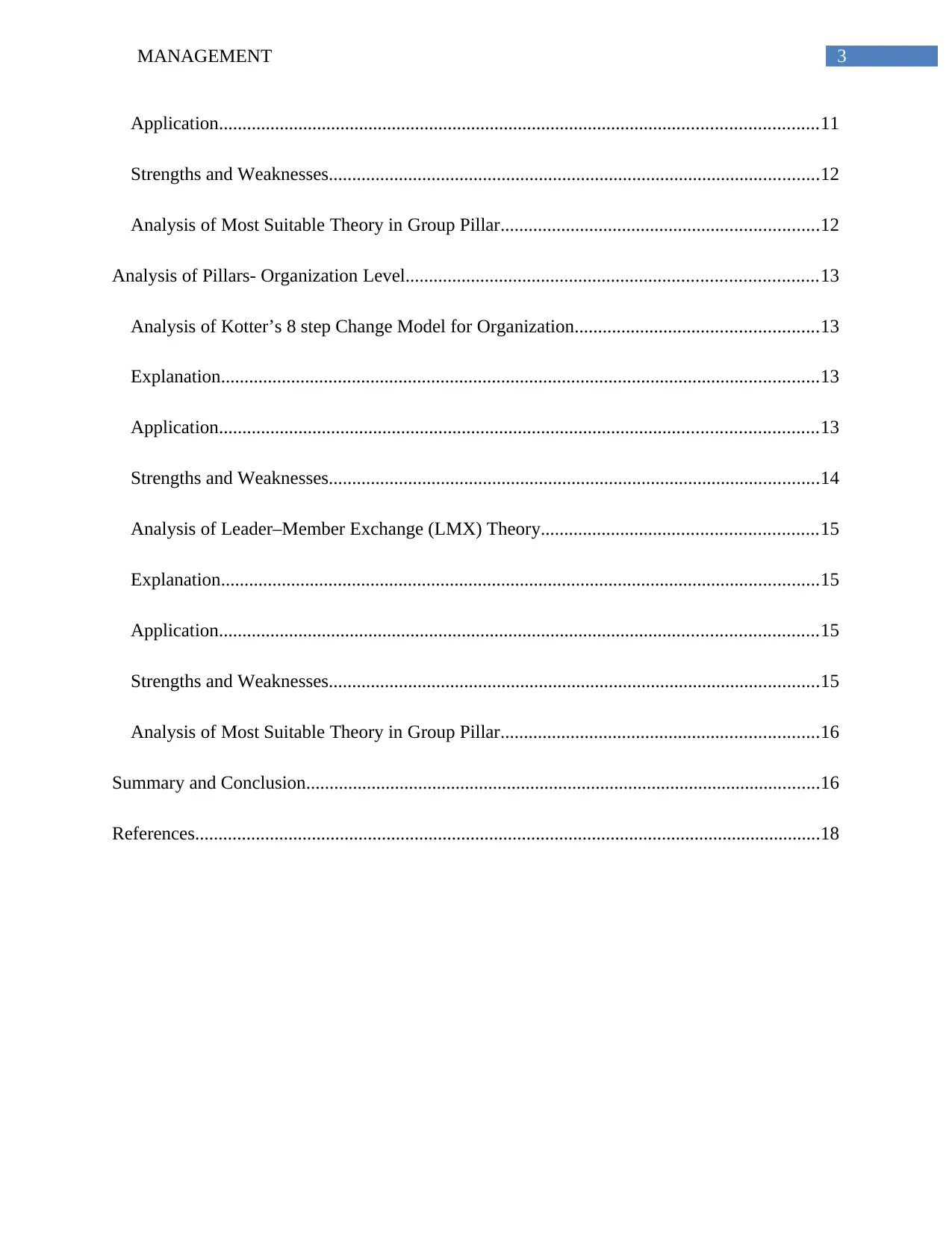
3MANAGEMENT
Application................................................................................................................................11
Strengths and Weaknesses.........................................................................................................12
Analysis of Most Suitable Theory in Group Pillar....................................................................12
Analysis of Pillars- Organization Level........................................................................................13
Analysis of Kotter’s 8 step Change Model for Organization....................................................13
Explanation................................................................................................................................13
Application................................................................................................................................13
Strengths and Weaknesses.........................................................................................................14
Analysis of Leader–Member Exchange (LMX) Theory...........................................................15
Explanation................................................................................................................................15
Application................................................................................................................................15
Strengths and Weaknesses.........................................................................................................15
Analysis of Most Suitable Theory in Group Pillar....................................................................16
Summary and Conclusion..............................................................................................................16
References......................................................................................................................................18
Application................................................................................................................................11
Strengths and Weaknesses.........................................................................................................12
Analysis of Most Suitable Theory in Group Pillar....................................................................12
Analysis of Pillars- Organization Level........................................................................................13
Analysis of Kotter’s 8 step Change Model for Organization....................................................13
Explanation................................................................................................................................13
Application................................................................................................................................13
Strengths and Weaknesses.........................................................................................................14
Analysis of Leader–Member Exchange (LMX) Theory...........................................................15
Explanation................................................................................................................................15
Application................................................................................................................................15
Strengths and Weaknesses.........................................................................................................15
Analysis of Most Suitable Theory in Group Pillar....................................................................16
Summary and Conclusion..............................................................................................................16
References......................................................................................................................................18
Paraphrase This Document
Need a fresh take? Get an instant paraphrase of this document with our AI Paraphraser
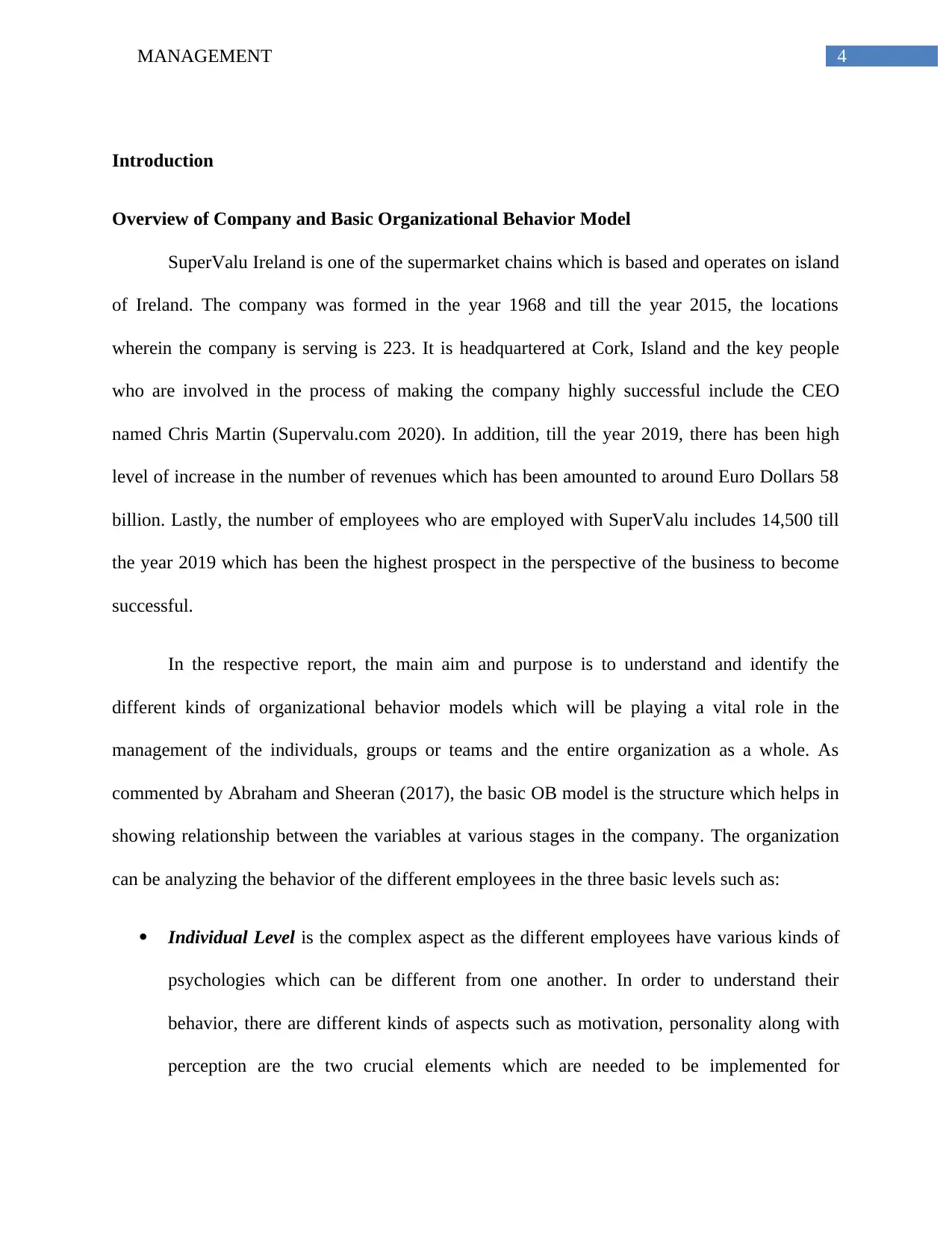
4MANAGEMENT
Introduction
Overview of Company and Basic Organizational Behavior Model
SuperValu Ireland is one of the supermarket chains which is based and operates on island
of Ireland. The company was formed in the year 1968 and till the year 2015, the locations
wherein the company is serving is 223. It is headquartered at Cork, Island and the key people
who are involved in the process of making the company highly successful include the CEO
named Chris Martin (Supervalu.com 2020). In addition, till the year 2019, there has been high
level of increase in the number of revenues which has been amounted to around Euro Dollars 58
billion. Lastly, the number of employees who are employed with SuperValu includes 14,500 till
the year 2019 which has been the highest prospect in the perspective of the business to become
successful.
In the respective report, the main aim and purpose is to understand and identify the
different kinds of organizational behavior models which will be playing a vital role in the
management of the individuals, groups or teams and the entire organization as a whole. As
commented by Abraham and Sheeran (2017), the basic OB model is the structure which helps in
showing relationship between the variables at various stages in the company. The organization
can be analyzing the behavior of the different employees in the three basic levels such as:
Individual Level is the complex aspect as the different employees have various kinds of
psychologies which can be different from one another. In order to understand their
behavior, there are different kinds of aspects such as motivation, personality along with
perception are the two crucial elements which are needed to be implemented for
Introduction
Overview of Company and Basic Organizational Behavior Model
SuperValu Ireland is one of the supermarket chains which is based and operates on island
of Ireland. The company was formed in the year 1968 and till the year 2015, the locations
wherein the company is serving is 223. It is headquartered at Cork, Island and the key people
who are involved in the process of making the company highly successful include the CEO
named Chris Martin (Supervalu.com 2020). In addition, till the year 2019, there has been high
level of increase in the number of revenues which has been amounted to around Euro Dollars 58
billion. Lastly, the number of employees who are employed with SuperValu includes 14,500 till
the year 2019 which has been the highest prospect in the perspective of the business to become
successful.
In the respective report, the main aim and purpose is to understand and identify the
different kinds of organizational behavior models which will be playing a vital role in the
management of the individuals, groups or teams and the entire organization as a whole. As
commented by Abraham and Sheeran (2017), the basic OB model is the structure which helps in
showing relationship between the variables at various stages in the company. The organization
can be analyzing the behavior of the different employees in the three basic levels such as:
Individual Level is the complex aspect as the different employees have various kinds of
psychologies which can be different from one another. In order to understand their
behavior, there are different kinds of aspects such as motivation, personality along with
perception are the two crucial elements which are needed to be implemented for
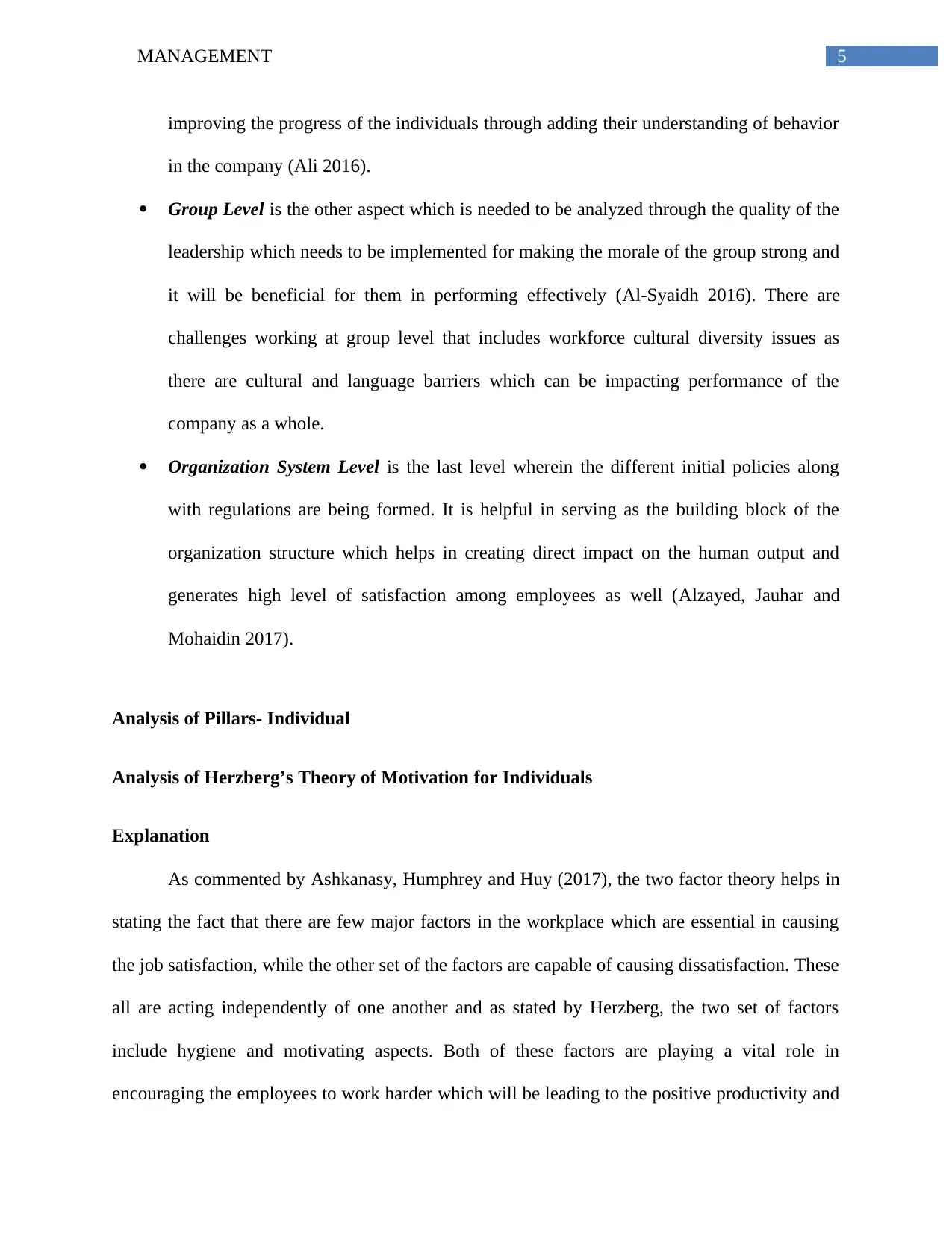
5MANAGEMENT
improving the progress of the individuals through adding their understanding of behavior
in the company (Ali 2016).
Group Level is the other aspect which is needed to be analyzed through the quality of the
leadership which needs to be implemented for making the morale of the group strong and
it will be beneficial for them in performing effectively (Al-Syaidh 2016). There are
challenges working at group level that includes workforce cultural diversity issues as
there are cultural and language barriers which can be impacting performance of the
company as a whole.
Organization System Level is the last level wherein the different initial policies along
with regulations are being formed. It is helpful in serving as the building block of the
organization structure which helps in creating direct impact on the human output and
generates high level of satisfaction among employees as well (Alzayed, Jauhar and
Mohaidin 2017).
Analysis of Pillars- Individual
Analysis of Herzberg’s Theory of Motivation for Individuals
Explanation
As commented by Ashkanasy, Humphrey and Huy (2017), the two factor theory helps in
stating the fact that there are few major factors in the workplace which are essential in causing
the job satisfaction, while the other set of the factors are capable of causing dissatisfaction. These
all are acting independently of one another and as stated by Herzberg, the two set of factors
include hygiene and motivating aspects. Both of these factors are playing a vital role in
encouraging the employees to work harder which will be leading to the positive productivity and
improving the progress of the individuals through adding their understanding of behavior
in the company (Ali 2016).
Group Level is the other aspect which is needed to be analyzed through the quality of the
leadership which needs to be implemented for making the morale of the group strong and
it will be beneficial for them in performing effectively (Al-Syaidh 2016). There are
challenges working at group level that includes workforce cultural diversity issues as
there are cultural and language barriers which can be impacting performance of the
company as a whole.
Organization System Level is the last level wherein the different initial policies along
with regulations are being formed. It is helpful in serving as the building block of the
organization structure which helps in creating direct impact on the human output and
generates high level of satisfaction among employees as well (Alzayed, Jauhar and
Mohaidin 2017).
Analysis of Pillars- Individual
Analysis of Herzberg’s Theory of Motivation for Individuals
Explanation
As commented by Ashkanasy, Humphrey and Huy (2017), the two factor theory helps in
stating the fact that there are few major factors in the workplace which are essential in causing
the job satisfaction, while the other set of the factors are capable of causing dissatisfaction. These
all are acting independently of one another and as stated by Herzberg, the two set of factors
include hygiene and motivating aspects. Both of these factors are playing a vital role in
encouraging the employees to work harder which will be leading to the positive productivity and
⊘ This is a preview!⊘
Do you want full access?
Subscribe today to unlock all pages.

Trusted by 1+ million students worldwide
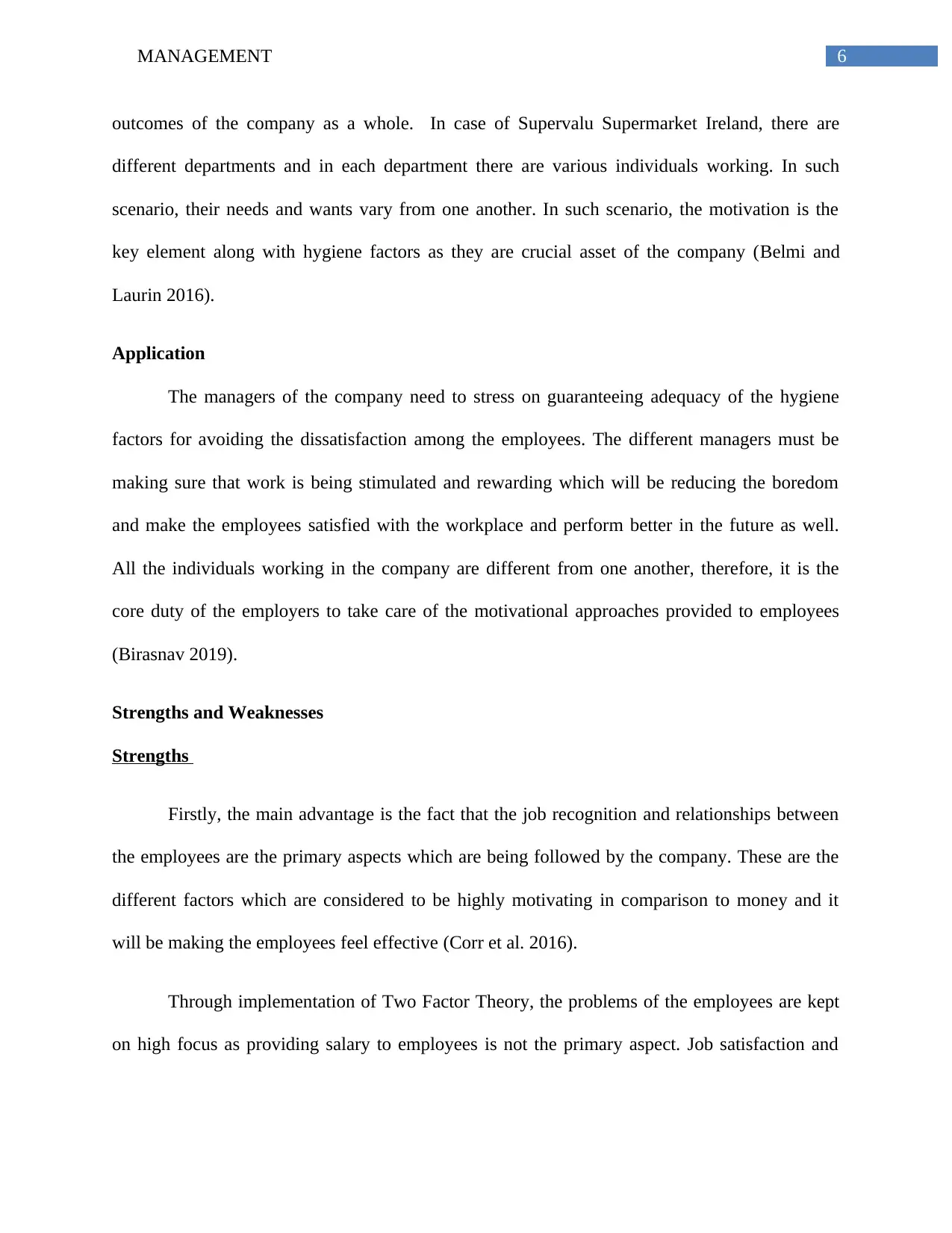
6MANAGEMENT
outcomes of the company as a whole. In case of Supervalu Supermarket Ireland, there are
different departments and in each department there are various individuals working. In such
scenario, their needs and wants vary from one another. In such scenario, the motivation is the
key element along with hygiene factors as they are crucial asset of the company (Belmi and
Laurin 2016).
Application
The managers of the company need to stress on guaranteeing adequacy of the hygiene
factors for avoiding the dissatisfaction among the employees. The different managers must be
making sure that work is being stimulated and rewarding which will be reducing the boredom
and make the employees satisfied with the workplace and perform better in the future as well.
All the individuals working in the company are different from one another, therefore, it is the
core duty of the employers to take care of the motivational approaches provided to employees
(Birasnav 2019).
Strengths and Weaknesses
Strengths
Firstly, the main advantage is the fact that the job recognition and relationships between
the employees are the primary aspects which are being followed by the company. These are the
different factors which are considered to be highly motivating in comparison to money and it
will be making the employees feel effective (Corr et al. 2016).
Through implementation of Two Factor Theory, the problems of the employees are kept
on high focus as providing salary to employees is not the primary aspect. Job satisfaction and
outcomes of the company as a whole. In case of Supervalu Supermarket Ireland, there are
different departments and in each department there are various individuals working. In such
scenario, their needs and wants vary from one another. In such scenario, the motivation is the
key element along with hygiene factors as they are crucial asset of the company (Belmi and
Laurin 2016).
Application
The managers of the company need to stress on guaranteeing adequacy of the hygiene
factors for avoiding the dissatisfaction among the employees. The different managers must be
making sure that work is being stimulated and rewarding which will be reducing the boredom
and make the employees satisfied with the workplace and perform better in the future as well.
All the individuals working in the company are different from one another, therefore, it is the
core duty of the employers to take care of the motivational approaches provided to employees
(Birasnav 2019).
Strengths and Weaknesses
Strengths
Firstly, the main advantage is the fact that the job recognition and relationships between
the employees are the primary aspects which are being followed by the company. These are the
different factors which are considered to be highly motivating in comparison to money and it
will be making the employees feel effective (Corr et al. 2016).
Through implementation of Two Factor Theory, the problems of the employees are kept
on high focus as providing salary to employees is not the primary aspect. Job satisfaction and
Paraphrase This Document
Need a fresh take? Get an instant paraphrase of this document with our AI Paraphraser

7MANAGEMENT
creating the employee friendly atmosphere are the two key elements which are being followed in
the respective theory (Gagné 2018).
Weaknesses
On the other hand, the major weakness is related to the fact that it can become subjective
at times as different people can be having various meanings for the job satisfaction. For instance-
Some employees may like flexible working hours, others may not prefer so and money is the key
element for them (Garg 2019).
Lastly, the theory ignores the external factors which in the reality play a vital role in
managing the efficiency of the employees.
Analysis of Maslow’s Hierarchy Theory
Explanation
As commented by Gelfand et al. (2017), with the help of Maslow’s Hierarchy Theory, it
will be beneficial in managing the different employees as per their needs. All the employees
working in the company have various desires and in order to meet the same, it is needed that
their basic needs are being met successfully. The theory comprises of five tier model in the
hierarchical format within a pyramid. The different needs include physiological, safety, love as
well as belonging, self-esteem and self-actualization. In case of the workplace, there are different
kinds of needs of employees which are basic and it will be beneficial in making them feel
motivated (Hobfoll et al. 2018).
creating the employee friendly atmosphere are the two key elements which are being followed in
the respective theory (Gagné 2018).
Weaknesses
On the other hand, the major weakness is related to the fact that it can become subjective
at times as different people can be having various meanings for the job satisfaction. For instance-
Some employees may like flexible working hours, others may not prefer so and money is the key
element for them (Garg 2019).
Lastly, the theory ignores the external factors which in the reality play a vital role in
managing the efficiency of the employees.
Analysis of Maslow’s Hierarchy Theory
Explanation
As commented by Gelfand et al. (2017), with the help of Maslow’s Hierarchy Theory, it
will be beneficial in managing the different employees as per their needs. All the employees
working in the company have various desires and in order to meet the same, it is needed that
their basic needs are being met successfully. The theory comprises of five tier model in the
hierarchical format within a pyramid. The different needs include physiological, safety, love as
well as belonging, self-esteem and self-actualization. In case of the workplace, there are different
kinds of needs of employees which are basic and it will be beneficial in making them feel
motivated (Hobfoll et al. 2018).
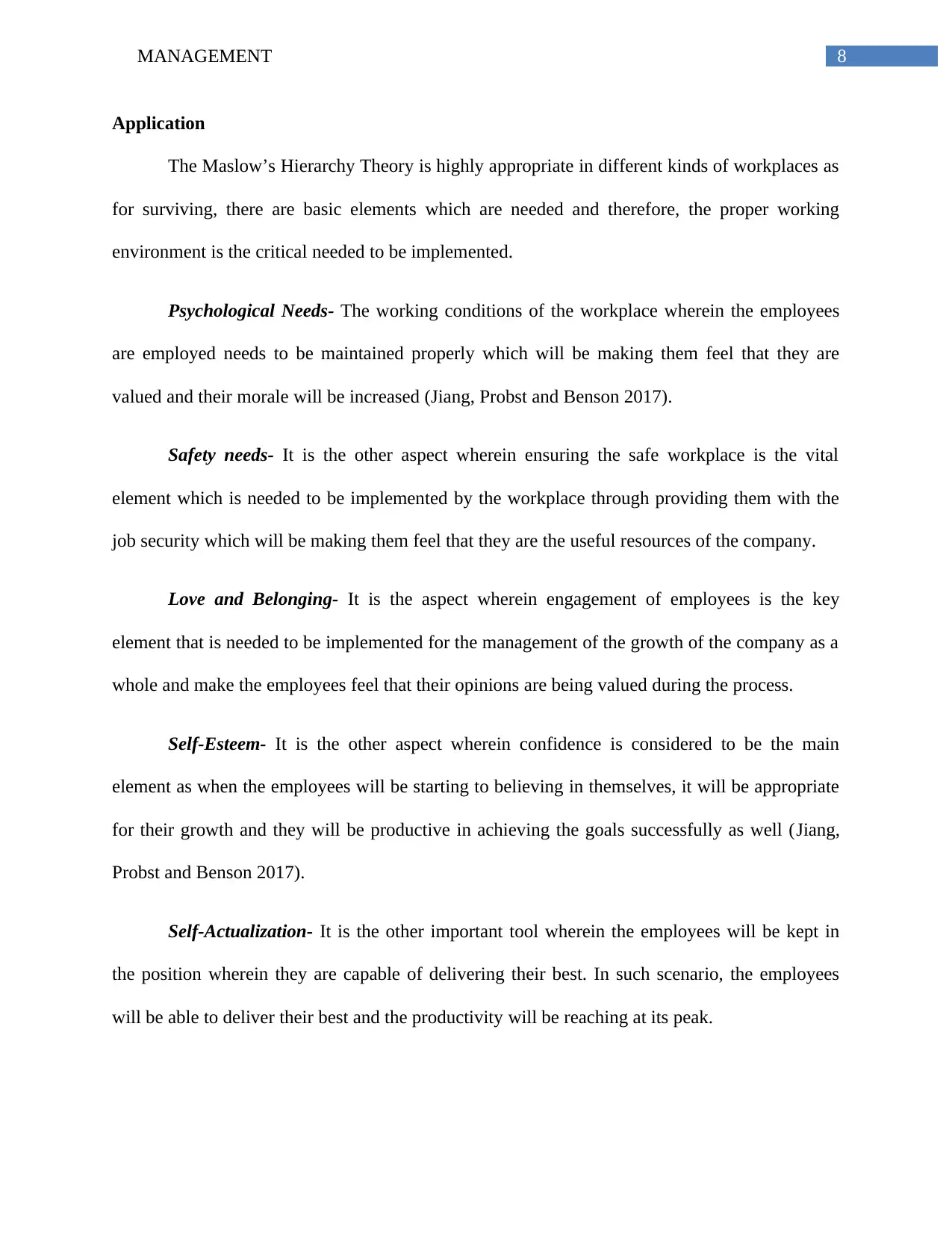
8MANAGEMENT
Application
The Maslow’s Hierarchy Theory is highly appropriate in different kinds of workplaces as
for surviving, there are basic elements which are needed and therefore, the proper working
environment is the critical needed to be implemented.
Psychological Needs- The working conditions of the workplace wherein the employees
are employed needs to be maintained properly which will be making them feel that they are
valued and their morale will be increased (Jiang, Probst and Benson 2017).
Safety needs- It is the other aspect wherein ensuring the safe workplace is the vital
element which is needed to be implemented by the workplace through providing them with the
job security which will be making them feel that they are the useful resources of the company.
Love and Belonging- It is the aspect wherein engagement of employees is the key
element that is needed to be implemented for the management of the growth of the company as a
whole and make the employees feel that their opinions are being valued during the process.
Self-Esteem- It is the other aspect wherein confidence is considered to be the main
element as when the employees will be starting to believing in themselves, it will be appropriate
for their growth and they will be productive in achieving the goals successfully as well (Jiang,
Probst and Benson 2017).
Self-Actualization- It is the other important tool wherein the employees will be kept in
the position wherein they are capable of delivering their best. In such scenario, the employees
will be able to deliver their best and the productivity will be reaching at its peak.
Application
The Maslow’s Hierarchy Theory is highly appropriate in different kinds of workplaces as
for surviving, there are basic elements which are needed and therefore, the proper working
environment is the critical needed to be implemented.
Psychological Needs- The working conditions of the workplace wherein the employees
are employed needs to be maintained properly which will be making them feel that they are
valued and their morale will be increased (Jiang, Probst and Benson 2017).
Safety needs- It is the other aspect wherein ensuring the safe workplace is the vital
element which is needed to be implemented by the workplace through providing them with the
job security which will be making them feel that they are the useful resources of the company.
Love and Belonging- It is the aspect wherein engagement of employees is the key
element that is needed to be implemented for the management of the growth of the company as a
whole and make the employees feel that their opinions are being valued during the process.
Self-Esteem- It is the other aspect wherein confidence is considered to be the main
element as when the employees will be starting to believing in themselves, it will be appropriate
for their growth and they will be productive in achieving the goals successfully as well (Jiang,
Probst and Benson 2017).
Self-Actualization- It is the other important tool wherein the employees will be kept in
the position wherein they are capable of delivering their best. In such scenario, the employees
will be able to deliver their best and the productivity will be reaching at its peak.
⊘ This is a preview!⊘
Do you want full access?
Subscribe today to unlock all pages.

Trusted by 1+ million students worldwide
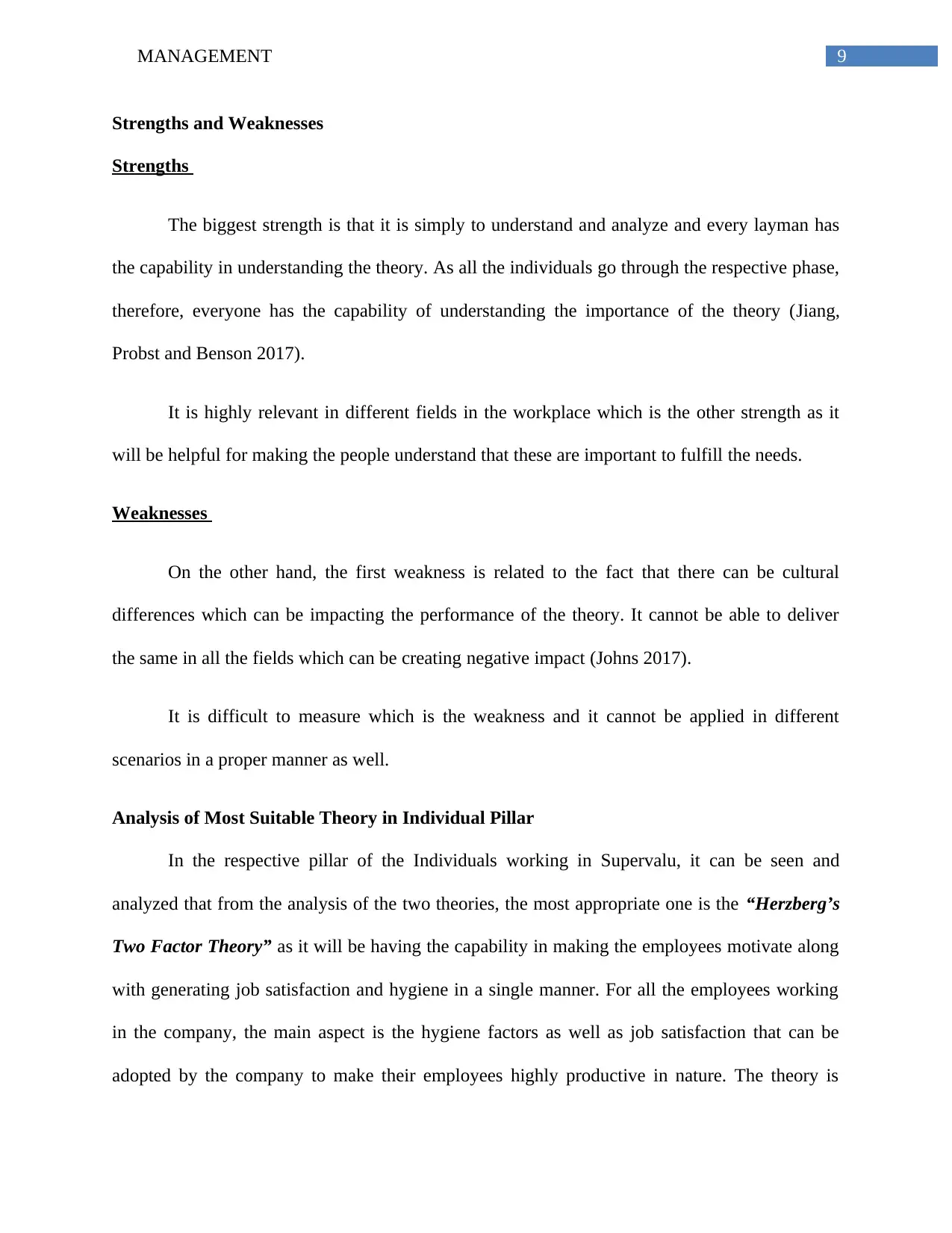
9MANAGEMENT
Strengths and Weaknesses
Strengths
The biggest strength is that it is simply to understand and analyze and every layman has
the capability in understanding the theory. As all the individuals go through the respective phase,
therefore, everyone has the capability of understanding the importance of the theory (Jiang,
Probst and Benson 2017).
It is highly relevant in different fields in the workplace which is the other strength as it
will be helpful for making the people understand that these are important to fulfill the needs.
Weaknesses
On the other hand, the first weakness is related to the fact that there can be cultural
differences which can be impacting the performance of the theory. It cannot be able to deliver
the same in all the fields which can be creating negative impact (Johns 2017).
It is difficult to measure which is the weakness and it cannot be applied in different
scenarios in a proper manner as well.
Analysis of Most Suitable Theory in Individual Pillar
In the respective pillar of the Individuals working in Supervalu, it can be seen and
analyzed that from the analysis of the two theories, the most appropriate one is the “Herzberg’s
Two Factor Theory” as it will be having the capability in making the employees motivate along
with generating job satisfaction and hygiene in a single manner. For all the employees working
in the company, the main aspect is the hygiene factors as well as job satisfaction that can be
adopted by the company to make their employees highly productive in nature. The theory is
Strengths and Weaknesses
Strengths
The biggest strength is that it is simply to understand and analyze and every layman has
the capability in understanding the theory. As all the individuals go through the respective phase,
therefore, everyone has the capability of understanding the importance of the theory (Jiang,
Probst and Benson 2017).
It is highly relevant in different fields in the workplace which is the other strength as it
will be helpful for making the people understand that these are important to fulfill the needs.
Weaknesses
On the other hand, the first weakness is related to the fact that there can be cultural
differences which can be impacting the performance of the theory. It cannot be able to deliver
the same in all the fields which can be creating negative impact (Johns 2017).
It is difficult to measure which is the weakness and it cannot be applied in different
scenarios in a proper manner as well.
Analysis of Most Suitable Theory in Individual Pillar
In the respective pillar of the Individuals working in Supervalu, it can be seen and
analyzed that from the analysis of the two theories, the most appropriate one is the “Herzberg’s
Two Factor Theory” as it will be having the capability in making the employees motivate along
with generating job satisfaction and hygiene in a single manner. For all the employees working
in the company, the main aspect is the hygiene factors as well as job satisfaction that can be
adopted by the company to make their employees highly productive in nature. The theory is
Paraphrase This Document
Need a fresh take? Get an instant paraphrase of this document with our AI Paraphraser
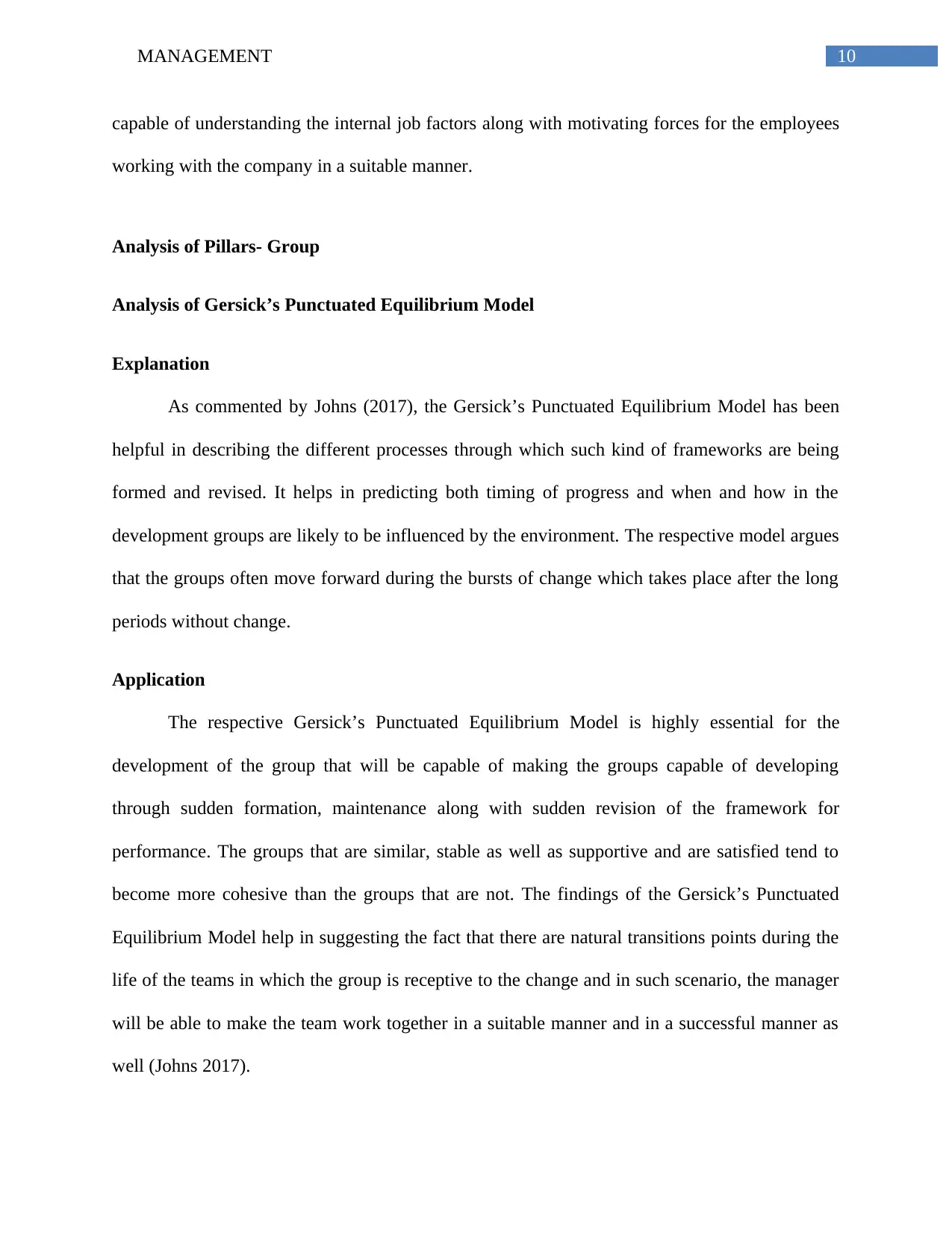
10MANAGEMENT
capable of understanding the internal job factors along with motivating forces for the employees
working with the company in a suitable manner.
Analysis of Pillars- Group
Analysis of Gersick’s Punctuated Equilibrium Model
Explanation
As commented by Johns (2017), the Gersick’s Punctuated Equilibrium Model has been
helpful in describing the different processes through which such kind of frameworks are being
formed and revised. It helps in predicting both timing of progress and when and how in the
development groups are likely to be influenced by the environment. The respective model argues
that the groups often move forward during the bursts of change which takes place after the long
periods without change.
Application
The respective Gersick’s Punctuated Equilibrium Model is highly essential for the
development of the group that will be capable of making the groups capable of developing
through sudden formation, maintenance along with sudden revision of the framework for
performance. The groups that are similar, stable as well as supportive and are satisfied tend to
become more cohesive than the groups that are not. The findings of the Gersick’s Punctuated
Equilibrium Model help in suggesting the fact that there are natural transitions points during the
life of the teams in which the group is receptive to the change and in such scenario, the manager
will be able to make the team work together in a suitable manner and in a successful manner as
well (Johns 2017).
capable of understanding the internal job factors along with motivating forces for the employees
working with the company in a suitable manner.
Analysis of Pillars- Group
Analysis of Gersick’s Punctuated Equilibrium Model
Explanation
As commented by Johns (2017), the Gersick’s Punctuated Equilibrium Model has been
helpful in describing the different processes through which such kind of frameworks are being
formed and revised. It helps in predicting both timing of progress and when and how in the
development groups are likely to be influenced by the environment. The respective model argues
that the groups often move forward during the bursts of change which takes place after the long
periods without change.
Application
The respective Gersick’s Punctuated Equilibrium Model is highly essential for the
development of the group that will be capable of making the groups capable of developing
through sudden formation, maintenance along with sudden revision of the framework for
performance. The groups that are similar, stable as well as supportive and are satisfied tend to
become more cohesive than the groups that are not. The findings of the Gersick’s Punctuated
Equilibrium Model help in suggesting the fact that there are natural transitions points during the
life of the teams in which the group is receptive to the change and in such scenario, the manager
will be able to make the team work together in a suitable manner and in a successful manner as
well (Johns 2017).

11MANAGEMENT
Strengths and Weaknesses
Strengths
The main strength of the respective model is that there is clarity in defining the roles of
the different team members who are involved in the process of the performance of the tasks
which will be appropriate for gaining competitiveness in the market (Kanfer and Chen 2016).
In addition, there will be building of the cohesive group wherein the members will be
capable of developing the strong bond wherein they will be more committed towards each other
and it will be leading to the success of the group as well (Kanfer and Chen 2016).
Weaknesses
On the other hand, the weakness which can be seen in the respective Gersick’s
Punctuated Equilibrium Model is the fact that the model is capable of solving the different
transitions which are sudden due to which it may not be suitable in all phases of the work culture
which are needed to be taking place (Kim, Ployhart and Gibson 2018).
Analysis of Tuckman’s Team Development Model
Explanation
As commented by Lord et al. (2019), the model of Tuckman helps in explaining the fact
that as the teams are capable of developing maturity as well as ability in maintaining the
relationships and the leader changes the leadership style. The respective five stage development
process helps the teams in becoming highly effective and high performing in nature which
improves their growth prospects in a suitable manner.
Strengths and Weaknesses
Strengths
The main strength of the respective model is that there is clarity in defining the roles of
the different team members who are involved in the process of the performance of the tasks
which will be appropriate for gaining competitiveness in the market (Kanfer and Chen 2016).
In addition, there will be building of the cohesive group wherein the members will be
capable of developing the strong bond wherein they will be more committed towards each other
and it will be leading to the success of the group as well (Kanfer and Chen 2016).
Weaknesses
On the other hand, the weakness which can be seen in the respective Gersick’s
Punctuated Equilibrium Model is the fact that the model is capable of solving the different
transitions which are sudden due to which it may not be suitable in all phases of the work culture
which are needed to be taking place (Kim, Ployhart and Gibson 2018).
Analysis of Tuckman’s Team Development Model
Explanation
As commented by Lord et al. (2019), the model of Tuckman helps in explaining the fact
that as the teams are capable of developing maturity as well as ability in maintaining the
relationships and the leader changes the leadership style. The respective five stage development
process helps the teams in becoming highly effective and high performing in nature which
improves their growth prospects in a suitable manner.
⊘ This is a preview!⊘
Do you want full access?
Subscribe today to unlock all pages.

Trusted by 1+ million students worldwide
1 out of 23
Related Documents
Your All-in-One AI-Powered Toolkit for Academic Success.
+13062052269
info@desklib.com
Available 24*7 on WhatsApp / Email
![[object Object]](/_next/static/media/star-bottom.7253800d.svg)
Unlock your academic potential
Copyright © 2020–2025 A2Z Services. All Rights Reserved. Developed and managed by ZUCOL.





